|
|
|
|
Strategic Analysis:
A Monthly Journal of the IDSA
Perceptions of Japanese Students on Terrorism and Other Security Problems: Initial Results from a Pilot Study
Mohammed Badrul Alam
*
Abstract
This paper is part of an international collaborative research project involving researchers from India, England, Japan and the United States. International terrorism has emerged as a major human concern after September 11, 2001 and an understanding of this against the backdrop of related security problems has emerged as a priority research area.
This paper presents preliminary findings of an exploratory pilot study. In the spring semester of 2002, undergraduate students in a Japanese college were surveyed about their views following the two major terrorist attacks of September 11, 2001 (New York and Washington) and December 13, 2001 (Indian Parliament). A total of 75 undergraduate students completed a self-administered questionnaire.
Introduction
International terrorism has become a major concern following the September 11, 2001 attacks and it is relevant to know the perceptions of youth around the world in this regard. An exploratory pilot study was undertaken to conduct a survey. A significant component of this pilot study is a collaborative research team with researchers from India, England, Japan and the United States. The objective of this exploratory research was to examine the perspectives of undergraduate students in Japan towards selected dimensions of contemporary international terrorism as well as other problems of concern. The study was completed in a short span of about 15 weeks.
Literature Review
There is a large body of literature available on international terrorism. Following September 11, 2001, a number of public opinion polls were conducted about international terrorism (CNN, Pew et. al.). Recently, the National Science Foundation funded a few social science research projects with a focus on international terrorism. These include Prof. Ronald Inglehart's project titled Islam and the West: Clash of Civilizations or Traumas of Modernization?,Prof. Kathleen Moore's project titled How Support Organizations Respond to Crises: Middle Eastern and Southern Asian American Organizations in the Aftermath of September 11,Prof. Andrew Conway's project titled A Test of Flashbulb Memory: Tuesday, September 11, 2001 and Prof. Mehdi Bozorgmehr's project titled How Support Organizations Respond to Crisis: Middle-Eastern and South Asian American Organizations in the Aftermath of September 11.Prof. Ronald Inglehart's project involves surveys in Pakistan and Bangladesh to measure public disapproval of the 9/11 attacks (Inglehart, 2001, # 0140566). Prof. Kathleen Moore's project explores public attitudes towards immigration and civil liberties following the 9/11 attacks (Moore, 2001, #0140271). Prof. Andrew Conway's psychology research assesses popular memory of 9/11 (Conway, 2001, #0139292) and Prof. Mehdi Bozorgmehr's project explores the attitudes of the leaders of national ethnic and religious organisations.
Data Sources
A total of 100 self-administered questionnaires were used in a graduate level college in a town in Japan in the spring semester from May 9 to 14, 2002. These questionnaires were distributed and collected in a classroom setting to eliminate the possibility of students consulting with each other or with members in their household. The academic orientation of this US-Japanese collaborative research was emphasised in the questionnaire. Completed questionnaires were returned to the author for data analysis. This paper tabulates 75 questionnaires that have been coded and computerised.
Student Profiles
Table 1 provides a summary of student profiles. The questionnaire was administered in the co-educational college, shows a diversity of views among the survey participants.
Table 1: Profile of Survey Participants

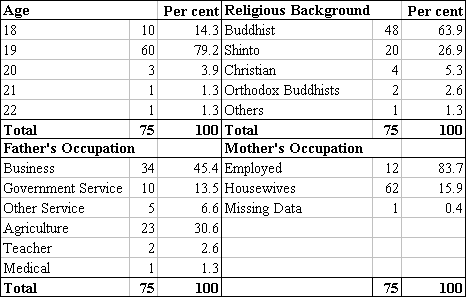
Preliminary Findings
Japanese Students' Perceptions of Terrorism and other Issues Faced by Japan
The questionnaire listed 17 issues faced by Japan and elicited importance ranking by the students. The list of problems and the student rankings are given in Table 2.
Table 2: Student Responses to Problems Faced by Japan
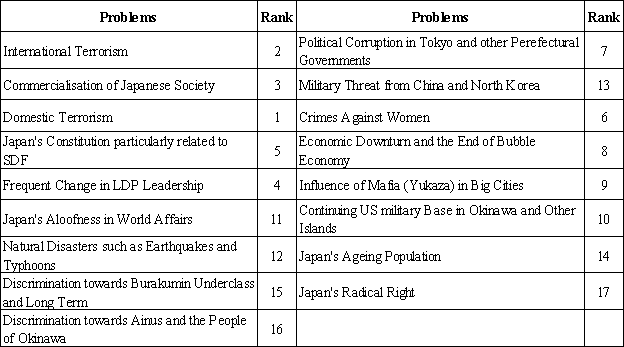
In the perception of a majority of students, domestic terrorism has the highest importance ranking ( 1) in Japan. It is very likely that the sarin gas attack of 1995 in the Tokyo subway influenced their perception and they are apprehensive over the possibility of copycat attacks after September 11. A majority of the students also ranked international terrorism as having the second highest importance.
Interestingly, the students have assigned Rank 3 to commercialization of Japanese society and Rank 4 to frequent changes in the LDP leadership. Issues related to the Constitution and the Self-Defence Force (SDF), crimes against women and political corruption received Ranks 5, 6 and 7 respectively. The Japanese economy was given Rank 8 and mafia influence in big cities Rank 9.
The military threat from China and North Korea (Rank 13) ranks lower than problems arising from US bases in Japan (Rank 10). Japan being 'aloof' in international affairs was accorded Rank 11.
Natural disasters, treatment of minorities and the radical right get very low rankings.
Japanese Students' Perceptions of Terrorism and other Issues Faced by USA
The list of issues for USA in the questionnaire given to the students is a variation of the basic list for Japan given in Table 2. It includes some US-specific issues. The list is given in Table 3, along with the importance rankings given by the students.
The students feel that international terrorism, cyber terrorism and homeland security have ranks 1, 2 and 3 respectively. Military threats to US interests gets Rank 4 and the economy Rank 5. Corporate crimes get a relatively high Rank 8. Surprisingly, pollution gets Rank 6, above military budget and inner city crimes.
Also, surprising is the importance ranking given to foreign visitors to US; Rank 17 (lowest). Perhaps this aspect can be explained by the fact that Japanese visitors in general, and Japanese students in particular, do not face any overt form of discrimination or harassment in USA.
Table 3: Student Responses to Problems Faced by USA
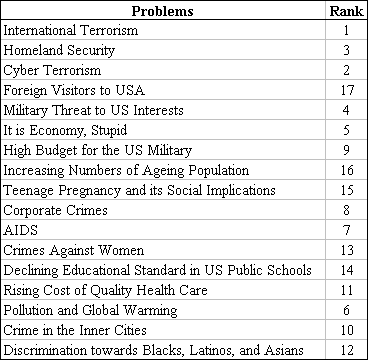
Japanese Students' Perceptions of Terrorism and other Issues Faced by India
The issues posed in the questionnaire for India are, of course, India-specific. Table 4 gives the list and the importance rankings assigned by the students.
Interestingly, communal conflicts in India are perceived as Rank 1. This is, possibly, due to the high coverage of the Gujarat riots of 2002 in Japanese media, both print and electronic. Indo-Pak tensions weigh in at Rank 2.
Surprisingly, domestic terrorism is assigned Rank 3 while international terrorism is Rank 14. The perception, possibly, is that the terrorism witnessed in Jammu and Kashmir is domestic in nature. This may imply that India's projections of cross border terrorism have not touched the minds of students in Japan.
The issue of Hindutva, again, receives a high Rank, 4. Perhaps the media exposure after the Gujarat riots has left a residue of concern about potential damage to India's diverse social fabric from divisive politics. Population growth comes in at Rank 5 and environmental degradation at 6.
uclearisation is ranked 7 in importance and is, obviously, not rated high. This is, possibly, indicative of increasing acceptance of India's nuclear status across many sections of Japanese society, including the student community.
The poor-rich disparity is ranked at 10. Issues like economic liberalisation, the coalition government at the Centre, discrimination and corruption came at the tail.
Table 4: Student Responses to Problems Faced by India

Self-Reported Feelings of Students about the 9/11 and 12/13 Terrorist Attacks
Tables 5 and 6 show selected direct quotes from the student respondents about these terrorist attacks.
Table 5: A Sample of Self-Reported Feelings About the World Trade Centre attack on September 11, 2001 (N=75)
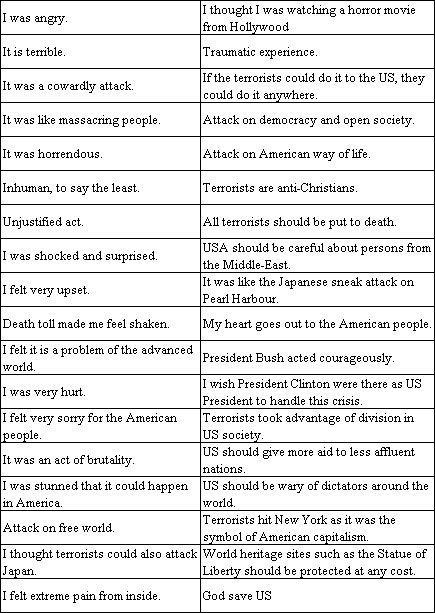
Table 6: A Sample of Open-Ended Comments on the Attack on the Indian Table 6: A Sample of Open-Ended Comments on the Attack on the Indian Parliament on December 13, 2001 (N=75)

These preliminary responses indicate some variations in orientation towards these two incidents of international terrorism.
Attitude towards International Terrorism
The students were given a series of propositions involving international terrorism to survey their attitudes. The propositions and responses are given in Table 7.
Table 7: Attitudes Towards International Terrorism (N = 75)

Over 80 per cent of the students agree that international terrorism is among the greatest threats to civilisation. There was a strong view (65 per cent) that terrorists hate America because of its wealth.
The responses reveal their very high interest, also, to learn more about the causes of international terrorism (99 per cent) and how to combat it (92 per cent).
Attitude towards Afghanistan
The students were also given a series of statements involving events in Afghanistan to elicit their attitudes. The propositions and responses are given in Afghanistan to elicit their attitudes. The propositions and responses are given in Table 8.
Table 8: Attitudes Towards Events in Afghanistan (N = 75)
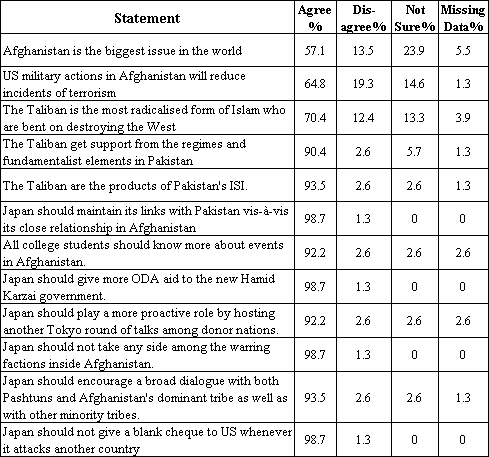
A very high percentage of the students (over 90 per cent) feel that Taliban is the product of Pakistan's ISI; and, that it got active support from the government and other fundamentalist elements. However, an overwhelming number of respondents (nearly 99 per cent) is also in favour of maintaining links with Pakistan so as to be engaged and exert maximum possible leverage. They were in favour of giving more ODA aid to bolster Karzai's government. Further, there is near unanimity that Japan should not side with one faction or another in Afghanistan.
Surprisingly, there is unanimity that US should not be given a free hand to attack another country at will. This implies that the US doctrine of pre-emptive strikes and extended self-defence does not find favour with this set of Japanese students who would like to see more of a proper and clear international endorsement in the application of military force.
Conclusion
This is an exploratory study with a small sample population size and indicates the need for larger, comprehensive surveys in the Japanese student community as well as similar communities in other countries.
Acknowledgement
The author thanks the two anonymous referees for their comments and suggestions on the paper.
References
Note *: Dr Mohammed Badrul Alam is Professor of History and Political Science at Miyazaki International College, Japan since 1998. He had his education at Utkal University, Bhubaneshwar, Jawaharlal Nehru University, New Delhi and Cornell University, New York, from where he earned MA, M Phil and PhD degrees respectively.
He has taught for over a decade in the United States and India at various educational institutions. Dr Alam is the author of several books including Essays on Nuclear Proliferation (1995) as well as numerous articles, monographs and book reviews published in international journals.
1. Allen, Harry et al., and Terrorism Today: The Past, the Present, the Future. 1999. Prentice-Hall.
2. Alexander, Yonah, International Terrorism: Political and Legal Documents. 1992. M Nijhoff; Dordrecht, Boston.
3. Asthana, N. C., and Anjali Nirmal, Terrorism, Insurgencies and Counterinsurgency Operations. 2001. Pointer Publishers; Jaipur.
4. Bodansky, Yossef, Bin Laden: The Man Who Declared War on America. 2001. Random House; New York.
5. Borer, Douglas A., Superpowers Defeated: A Comparison of Vietnam and Afghanistan. 2000. Frank Cass Publications.
6. Borovik, Artyom, The Hidden War. 2001. Grove Press.
7. Bozorgmehr, Mehdi, How Support Organizations Respond to Crises: Middle Eastern and Southern Asian American Organizations in the After math of September 11. Abstract of NSF Grant No. #0140271, 2001.
8. Browne, Marjorie Ann, International Terrorism. 1978. Congressional Research Service, Library of Congress, Washington, DC.
9. Burbach, Roger, September 11 and the US War: Beyond the Curtain of Smoke. 2002. City Lights Books.
10. Chellaney, Brahma. Fighting Terrorism in Southern Asia: the Lessons of History. International Security. 2001, 26 (3) 94-116.
11. Child, Greg, Over the Edge. 2002. Random House.
12. Chomsky, Noam, Pirates and Emperors: International Terrorism in the Real World. 1991.Black Rose Books; Montreal/New York, N.Y.
13. Cooley, John K., Unholy Wars: Afghanistan, America, and International Terrorism. 2000. Pluto Press; London.
14. Conway, Andrew, A Test of Flashbulb Memory: Tuesday, September 11, 2001. Abstract of NSF Grant No. #0139292.
15. Cordesman, Anthony, Terrorism, Asymmetric Warfare and Weapons of Mass Destruction. 2001. Greenwood Press.
16. Crenshaw, Martha, and John Pimlott. International Encyclopedia of Terrorism. 1997. Fitzroy Dearborn; London.
17. Desai, Jatin, India and US on Terrorism. 2000. Commonwealth; New Delhi.
18. Donovan, Gill, Poll Reports Attitude on Terrorism, Violence. National Catholic Reporter. 2002, 38 (11) 7.
19. Emerson, Steven, American Jihad. 2002. Free Press.
20. Griffin, Michael, Reaping the Whole Wind: The Taliban Movement in Afghanistan. 2000. Avalon Publishing Group.
21. Heuvel, Katrine, A Just Response: The Nation on Terrorism and Democracy. 2002. Avalon Publishing Group.
22. Hughs, Christopher, Japan's Economic Power and Security. 1999. Routledge.
23. Inglehart, Ronald, Islam and the West: Clash of Civilisations or Traumas of Modernisation? Abstract of NSF Grant No. 0140566, 2001.
24. Japan's Role on War on Terror. The Japan Times. September 24, 2001.
25. Jeurgensmeyer, Mark, Terror in the Mind of God: The Global Rise of Religious Violence. 2001. University of California Press.
26. Kamalipour, Yahya, Images of the US Around the World: A Multicultural Perspective. 1999. State University of NY Press.
27. Kegley, Charles W. Jr., International Terrorism: Charcteristics, Causes, Controls. 1990. St. Martin's; New York, NY.
28. Klare, Michael, Resource Wars: The New Landscape of Global Conflict. 2002. Henry Holt; New York.
29. Kumamoto, Robert, International Terrorism and American Foreign Relations, 1945-1976.1999. Northeastern University Press; Bethesda, MD.
30. Lesser, Ian, et al., Considering the New Terrorism. 1999. Rand Corporation.
31. LePoer, Barbara Litch, Terrorism India. 2001. Congressional Research Service, Library of Congress/Penny Hill Press; Bethesda, MD.
32. Marsden, Peter, Taliban: War and Religion in Afghanistan. 2002. Zed Books.
33. Mickolus, Edward F. International Terrorism: Attributes of Terrorist Events, 1968-1977.1982. Inter-University Consortium for Political and Social Research: Ann Arbor, Michigan.
34. Moore, Kathleen, Terror, Immigration, and Civil Liberties in the United States. Abstract of NSF Grant No. 0201149, November 30, 2001.
35. Murakami, Haruki et al., Underground: The Tokyo Gas Attack and the Japanese Psyche. 2001. Vintage Books.
36. National Foreign Assessment Center. International Terrorism. Washington.
37. Nitcavic, Richard G., and Ralph E. Dowling, American Perceptions of Terrorism: A Q-Methodological Analysis of Types. Political Communication and Persuasion. 1990, 7 (3) 147-166
38. Noone, Michael F., and Yonah Alexander, Cases and Materials on Terrorism: Three Nations' Response. 1997. Kluwer Law International; London.
39. Parenti, Michael, The Terrorism Trap: September 11 and Beyond. 2002. City Light Books.
40. Perera, Amrith Rohan, International Terrorism. 1997. Vikas Publishing House; New Delhi.
41. Peters, Ralph, Beyond Terror. 2002. Skackpole Books.
42. "Attacks At Home Draw More Interest Than War Abroad. The Pew Research Center at http://208.240.91.18/102201que.htm
43. Pillar, Paul, Terrorism and US Foreign Policy. 2001. Brookings Institution Press; Washington DC.
44. Puri, Balraj, Commentary-India and the War Against Terrorism. Economic and Political Weekly. 2001, 30 (40) 3805.
45. Qadir, Shaukat, The Concept of International Terrorism: An Interim Study of South Asia. The Round Table. 2001, 333-343.
46. Rall, Ted, To Afghanistan and Back. 2002. N.B.M. Publishing Company.
47. Rosie, George, The Directory of International Terrorism. 1986. Mainstream; Edinburgh.
48. Schlagheck, Donna M., International Terrorism: An Introduction to the Concepts and Actors. 1988. Lexington Books; Lexington, Mass.
49. Simon, Jeffrey D.U.S., Countermeasures Against International Terrorism. 1990. RAND Corporation, Santa Monica, CA.
50. Thomas, Gordon, Seeds of Fire: China and the Story Behind the Attack on America. 2002. Dadelon Books.
51. Tackling Global Terrorism. The Japan Times. February 21, 2002.
52. Tien, Hung-Mao et al., The Security Environment in the Asia-Pacific. 1999. M.E. Sharpe.
53. Tucker, David, Skirmishes at the Edge of Empire: The United States and International Terrorism. 1997. Praeger; Westport, Conn.
54. International Instruments Related to the Prevention and Suppression of International Terrorism. 2001. United Nations; New York.
55. Vajpayee, Atal Behari, India: Prime Minister's Address to the Nation on Terrorist Attacksin the United States. 2001. Embassy of India, Washington DC.
56. Youngs, Tim, The Campaign Against International Terrorism: Prospects After the Fall of the Taliban. 2001. House of Commons Library; London.
57. Vidal, Gore, Perpetual War for Perpetual Peace. 2002. Avalon Publishing Group.